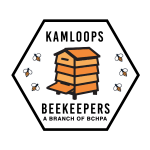Native Pollinators
Bees can be divided into two groups by their lifestyles: solitary or social. Only a few species of bees are social. Social bees share a nest, and divide the work of building the nest, caring for the offspring, and foraging for pollen and nectar. The principal social bees are the honeybee (not native to BC) and the bumble bees (about forty-five species in BC).
There are well over 450 species of native bees in BC and over 4000 in North America, of which 70% are ground nesters. Others live in cavities of dead wood or pithy stems. They are mostly solitary, meaning that after mating, they prepare and provision their nests without cooperation with other bees. Although they often will nest together in great numbers when a good nesting area is found, the bees are only sharing a good nesting site (like people wanting to live in a condo in Mexico) and not cooperating.
Solitary bees have a short flying life span (often only 2-3 weeks) and a short foraging range of only 100-200 metres from their nesting sites. Bees pass through four stages during its lifetime: egg, larva, pupa, and adult. It is only the last of these, the adult, which we see and recognize as a bee. During the first three stages, the bee is inside the brood cell of the nest. The egg resembles a tiny white sausage and lasts from one to three weeks before hatching into a white, soft-bodied, grub-like larva. The larva is the stage when most of the growth occurs, feeding on a food supply left in the cell by the mother. After the period of rapid growth, the larva changes into a pupa. During this apparently dormant stage, which may last eight or nine months, the bee transforms into its adult form within a protective outer layer. When they emerge from this, the adult bees are fully-grown and ready to feed, mate, and continue the cycle.
Bumble bees are the only truly social group of native bees. And they are the only native bee that make honey.They live in colonies, share the work, and have multiple, overlapping generations throughout the spring, summer, and fall. However, unlike the non-native, European honey bees, the bumble bee colony is seasonal. At the end of the summer only the fertilized queens survive to hibernate through the winter. In the spring, she will found a new nest that eventually may grow to include dozens of individuals (occasionally a couple of hundred)
Bumble bees need a cavity in which to nest. The queens are opportunists, looking for any suitably sized cavity. Sometimes this is above ground, such as in hollow trees or walls, or under a tussock of grass, but they mostly nest underground. An abandoned rodent hole is a favorite, as this space is warm and already lined with fur. The queen creates the first few brood cells from wax, and then provisions them with pollen and nectar and lays eggs. It will take about a month for her to raise the first brood. When they emerge, these bees become workers, taking on the tasks of foraging and helping the queen tend the growing number of brood cells. The workers may live for a couple of months, by which time there will be more bumble bees to replace them. The queen will continue to lay eggs, so the colony will grow steadily through the summer. At the end of summer, new queens and drones will emerge and mate. As the cooler weather of fall arrives most of the bees, including the old queen, will die, leaving only the new, mated queens to overwinter.
Forage Needs for wild pollinators: Forage resources are necessary throughout a pollinator’s life. A diverse community of insect pollinators requires a diversity of native flowers within an un-fragmented habitat that consists of many species of flowers with different flower shapes and that bloom at different times during the season.
Nesting and egg-laying resources for wild pollinators: In addition to food, insect pollinators require egg-laying sites and over-wintering sites for queen bees.
Links to more information about Native Pollinators
Master Gardeners Association
www.mgabc.org
City of Kamloops
Integrated Pest Management & Healthy Landscapes
www.kamloops.ca/ipm
XERCES Society Pollinator Conservation Program
www.xerces.org
Pollinator Partnership
www.pollinator.org
Pollination Canada
www.pollinationcanada.ca
An excellent source, encourages people to become pollinator observers and contains observation forms for download.
The Canadian Pollination Initiative
www.uoguelph.ca/canpolin
Naturescape British Columbia
naturescapebc.ca
Contains information about habitat loss and green spaces.
Canadian Wildlife Association
www.WildAboutGardening.org
